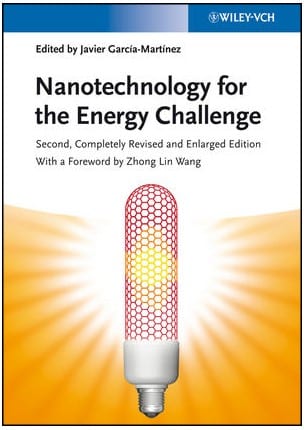 Nanotechnology for the Energy Challenge, 2nd Edition
Nanotechnology for the Energy Challenge, 2nd Edition
Javier García-Martínez (Editor), Zhong Lin Wang (Foreword by)
ISBN: 978-3-527-33380-6
Hardcover / E-book
664 pages
$210.00 / $169.99
Click here for more information
Reviewed by Markku Leskelä, University of Helsinki, Finland
The second edition of Nanotechnology for the Energy Challenge was finished only three years after the publication of its first edition. This is quite exceptional but perfectly understandable because of the many breakthroughs in this fast- paced area. The book is structured along the three natural divisions of the topic: energy production, storage and efficient usage. These three thematic parts, each one containing relevant chapters, are written by the world’s leading experts in the field and provide the most comprehensive, up-to-date and authoritative appraisal of how nanotechnology is contributing to the energy field. Sustainable Energy Production covers clean energy production and conversion, including photovoltaics, thermal-electrical energy conversion, energy harvesting (piezoelectric materials), fuel cells, hydrogen production, and nanocatalysts for Fischer-Tropsch synthesis. Efficient Energy Storage focuses on the potential use of nanomaterials in hydrogen storage, advanced batteries, supercapacitors (carbon based materials) and superconductors. Finally, the Energy Sustainability theme has the following topics: energy savings through green nanofabrication, advanced catalysis for fuel production, nanocatalysts for biofuel applications, nanostructured light-emitting and eletrochromic devices and CO2 capture by nanoporous materials. The list of topics is quite comprehensive and wisely chosen. Owing to the research activity of the editor of this book, there is a significant focus on catalysis for energy applications, with three chapters devoted to this very interesting topic.
The revision and enlargement of the book has been extensive, with the number of chapters increasing from 15 to 18 and the work now reaching well over 600 pages. More importantly however, existing chapters have been updated to incorporate the latest advances in this rapidly growing field. It might have been possible to add more chapters to the book, for example semiconductor nanostructures for low-power electronics, nanomembranes for efficient separation etc, but efforts to keep the size of the book reasonable clearly precluded their incorporation. The chosen topics are certainly the most interesting, important and widely studied.
The writing style flows well throughout the book and despite having different authors the level and depth of each chapter is surprisingly even. The balanced content, selection of high-level authors and harmonized texts are a credit to the editor. He has refreshed the book whilst maintaining its quality, a difficult balancing act accomplished very nicely.
Technically the book is excellent: there is a good index of terms, and the pictures and graphical illustrations add clarity. Each chapter is well referenced for readers desiring further information – giving a handbook character to the book.
This book can and should please readers of many stripes. It can work as an introduction to the nanotechnology field, a handbook for those working in the field, or a text book for students at advanced level. Furthermore, people from very different educational backgrounds can read and use it – be they chemists, physicists, materials scientists or engineers – because the texts do not demand specific theoretical background. This book should definitely be on the shelf of every person curious about nanotechnology and its role in providing solutions to our energy challenge.

















